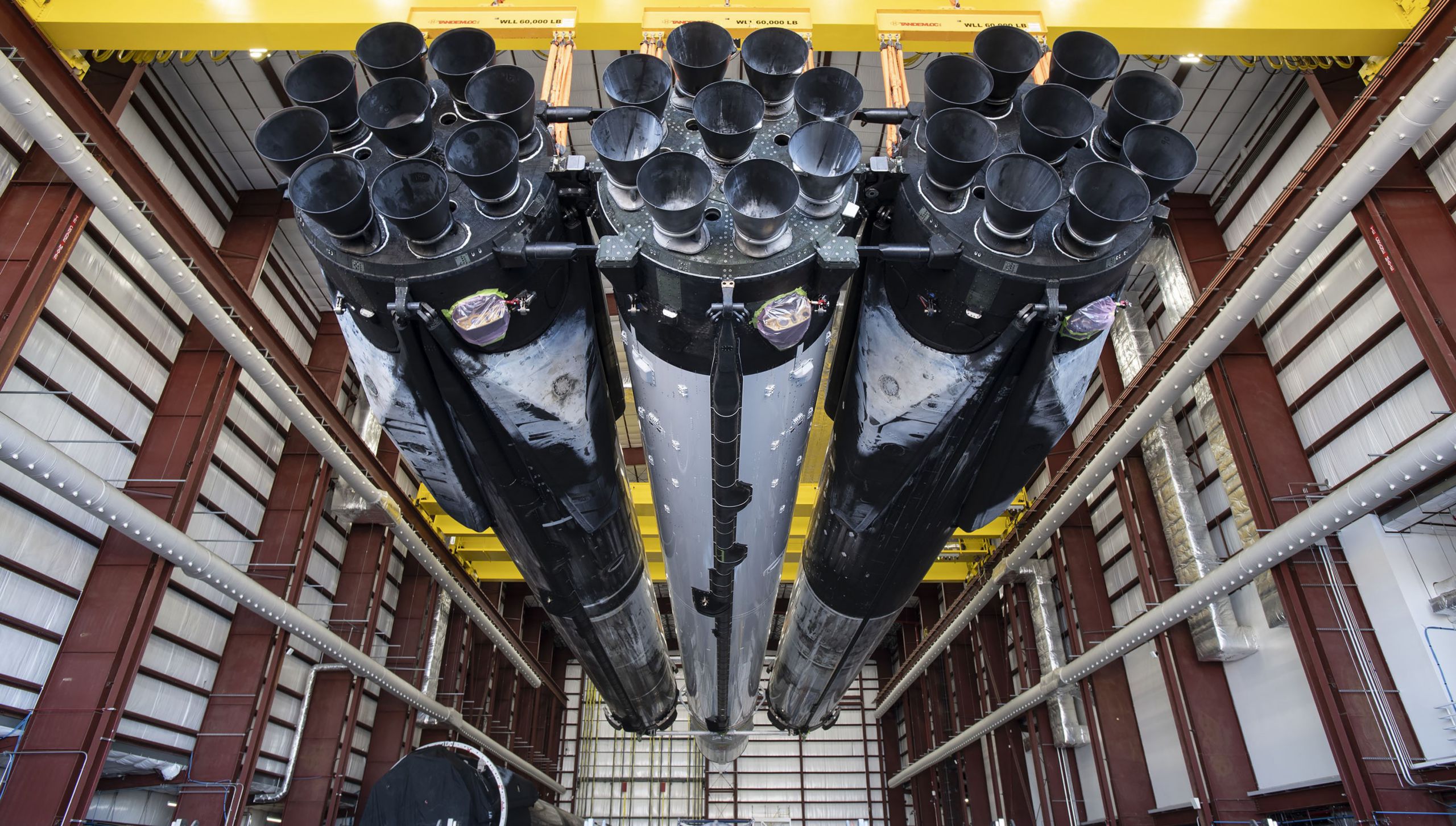
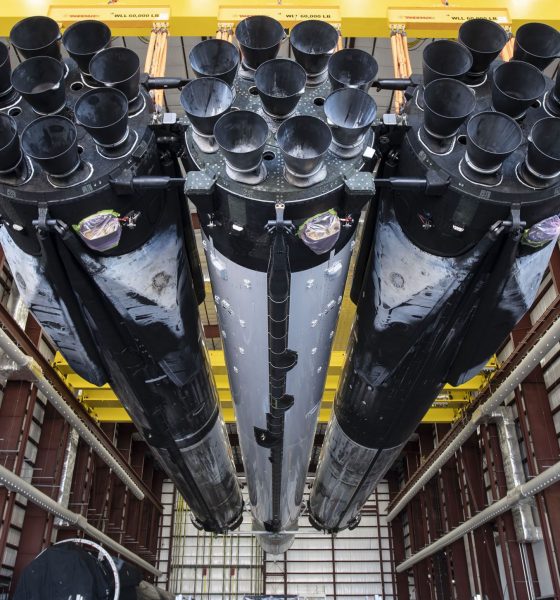
News
SpaceX Falcon Heavy rocket rolls out for first launch of 2023
SpaceX has assembled Falcon Heavy and rolled the rocket out to the launch pad for its first mission of 2023.
This particular Falcon Heavy – the fifth overall – is reusing both of the side boosters recovered from the rocket’s fourth launch. Originally scheduled to launch in late 2020, Falcon Heavy Flight 4 finally lifted off from the NASA Kennedy Space Center’s LC-39A pad on November 1st, 2022. The two-year delay was caused almost exclusively by unspecified issues with one or several of the US Space Force-44 (USSF-44) mission’s payloads, forcing SpaceX to store completed Falcon Heavy boosters for more than a year and a half.
The update that's rolling out to the fleet makes full use of the front and rear steering travel to minimize turning circle. In this case a reduction of 1.6 feet just over the air— Wes (@wmorrill3) April 16, 2024
Thankfully, despite an unplanned 40-month hiatus between missions, the US Space Force reported that Falcon Heavy’s fourth launch was a “simply outstanding” success. USSF-44 was SpaceX’s first attempt at a direct geosynchronous launch – one of the most difficult missions for rockets that use cryogenic liquid propellant. Falcon Heavy first launched payloads to a highly-elliptical parking orbit (~300 km x ~36,000 km) and then coasted for around six hours in the harsh vacuum of space. Once the Falcon upper stage reached that 36,000-kilometer (~22,250 mi) apogee, all the while fighting to keep its propellant from freezing into slush and boiling into gas, it ignited again to complete a circularization burn – raising the low end of its orbit (perigee) to match the apogee.
The payloads were likely deployed around 6-8 hours after liftoff. To complete such a challenging mission, SpaceX was forced to intentionally sacrifice one of Falcon Heavy’s three potentially reusable boosters. But about eight minutes after liftoff, both of the rocket’s side boosters safely touched down side by side at SpaceX’s LZ-1 and LZ-2 landing zones. Before the launch, military officials had confirmed that those boosters – B1064 and B1065 – were already expected to fly again on Falcon Heavy’s next Space Force launch, USSF-67.
Less than 70 days after their first launch and landing, SpaceX has refurbished B1064 and B1065; attached the boosters to another expendable Falcon Heavy center core and upper stage, and rolled the rocket out to Pad 39A for prelaunch testing. Its payloads and exact launch time are different, but USSF-67 is expected to be virtually identical to USSF-44 – launching directly to GSO with a lightweight collection of miscellaneous experiments and small satellites. The center core will be expended and B1064 and B1065 will attempt another simultaneous landing at LZ-1 and LZ-2.
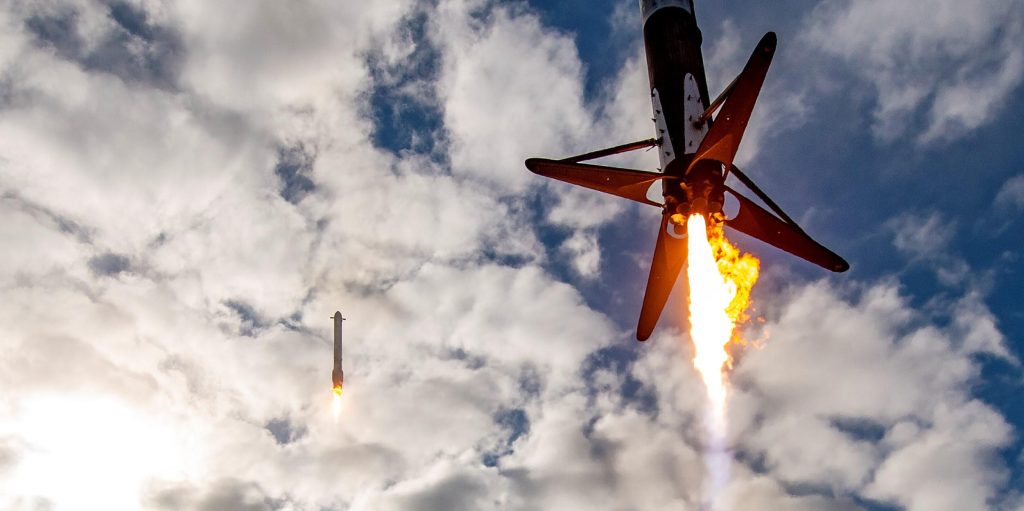
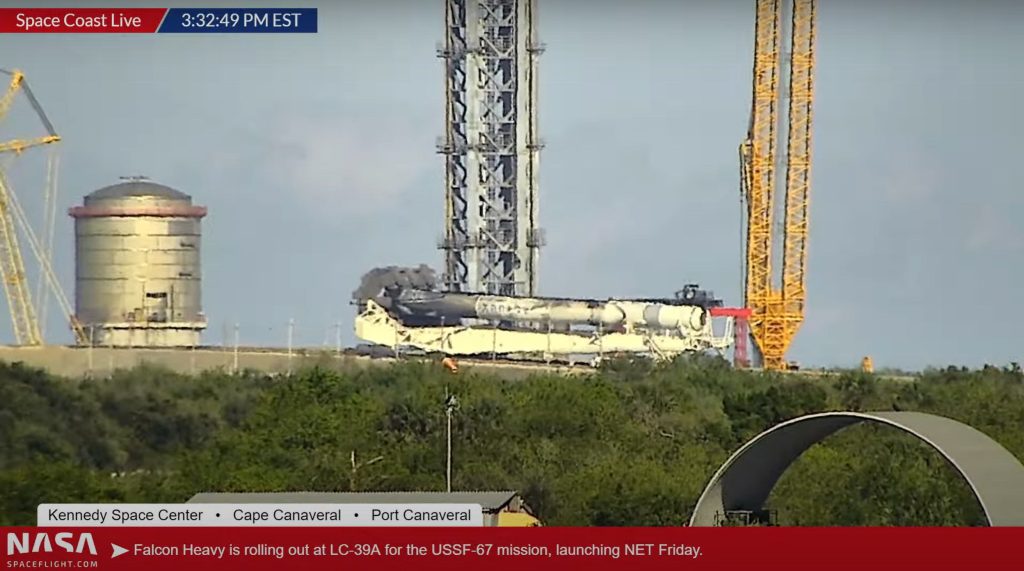
Like USSF-44, USSF-67’s rocket rolled out for the first time without its cone-like payload fairing installed. Up next, Falcon Heavy will need to complete a wet dress rehearsal and static fire test before SpaceX and the USSF can clear it for flight. SpaceX will then lower the rocket to the ground, return it to the hangar, install the USSF-67 payload, roll the rocket back to the pad, and raise it vertical.
Unofficial but well-sourced public manifests report that SpaceX intends to launch USSF-67 four days from now, shortly before 6 pm EST (23:00 UTC) on Friday, January 13th. SpaceX took five and a half days to complete the same process for USSF-44, so a delay to January 14th or 15th would not be surprising. But at the moment, Friday’s launch attempt is scheduled shortly after sunset, potentially producing the same kind of extraordinary light shows Falcon 9 has become famous for. However, that show would be significantly magnified by Falcon Heavy’s three boosters and twin boostback burns, potentially making it one of the most visually spectacular launches ever.
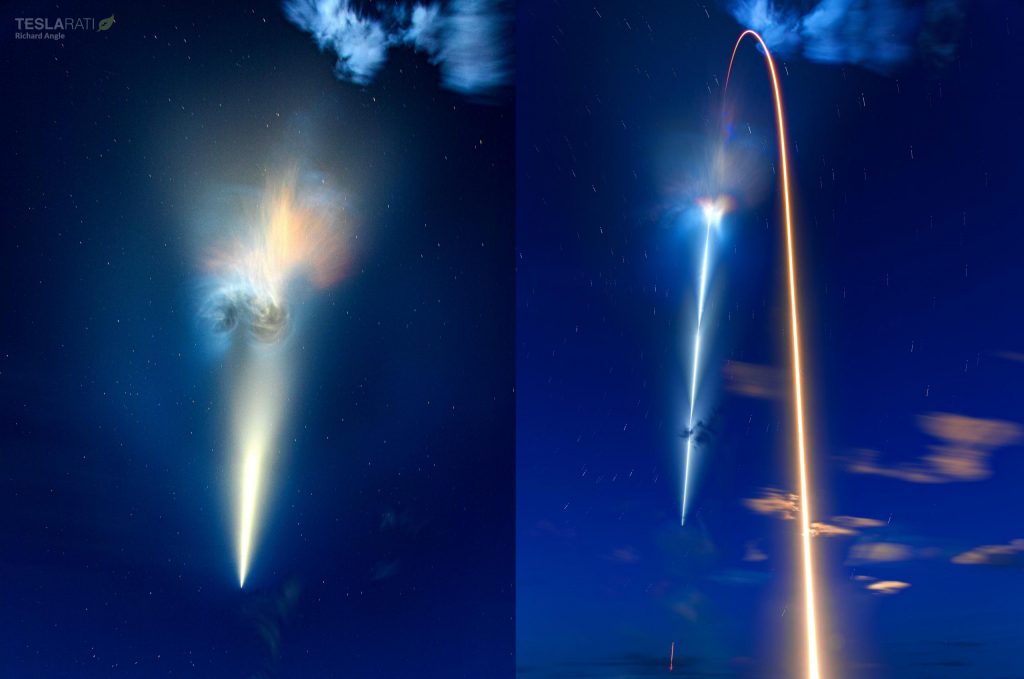

News
Tesla aims to combat common Full Self-Driving problem with new patent
Tesla writes in the patent that its autonomous and semi-autonomous vehicles are heavily reliant on camera systems to navigate and interact with their environment.

Tesla is aiming to combat a common Full Self-Driving problem with a new patent.
One issue with Tesla’s vision-based approach is that sunlight glare can become a troublesome element of everyday travel. Full Self-Driving is certainly an amazing technology, but there are still things Tesla is aiming to figure out with its development.
Unfortunately, it is extremely difficult to get around this issue, and even humans need ways to combat it when they’re driving, as we commonly use sunglasses or sun visors to give us better visibility.
Cameras obviously do not have these ways to fight sunglare, but a new patent Tesla recently had published aims to fight this through a “glare shield.”
Tesla writes in the patent that its autonomous and semi-autonomous vehicles are heavily reliant on camera systems to navigate and interact with their environment.

The ability to see surroundings is crucial for accurate performance, and glare is one element of interference that has yet to be confronted.
Tesla described the patent, which will utilize “a textured surface composed of an array of micro-cones, or cone-shaped formations, which serve to scatter incident light in various directions, thereby reducing glare and improving camera vision.”

The patent was first spotted by Not a Tesla App.
The design of the micro-cones is the first element of the puzzle to fight the excess glare. The patent says they are “optimized in size, angle, and orientation to minimize Total Hemispherical Reflectance (THR) and reflection penalty, enhancing the camera’s ability to accurately interpret visual data.”
Additionally, there is an electromechanical system for dynamic orientation adjustment, which will allow the micro-cones to move based on the angle of external light sources.
This is not the only thing Tesla is mulling to resolve issues with sunlight glare, as it has also worked on two other ways to combat the problem. One thing the company has discussed is a direct photon count.
CEO Elon Musk said during the Q2 Earnings Call:
“We use an approach which is direct photon count. When you see a processed image, so the image that goes from the sort of photon counter — the silicon photon counter — that then goes through a digital signal processor or image signal processor, that’s normally what happens. And then the image that you see looks all washed out, because if you point the camera at the sun, the post-processing of the photon counting washes things out.”
Future Hardware iterations, like Hardware 5 and Hardware 6, could also integrate better solutions for the sunglare issue, such as neutral density filters or heated lenses, aiming to solve glare more effectively.
Elon Musk
Delaware Supreme Court reinstates Elon Musk’s 2018 Tesla CEO pay package
The unanimous decision criticized the prior total rescission as “improper and inequitable,” arguing that it left Musk uncompensated for six years of transformative leadership at Tesla.

The Delaware Supreme Court has overturned a lower court ruling, reinstating Elon Musk’s 2018 compensation package originally valued at $56 billion but now worth approximately $139 billion due to Tesla’s soaring stock price.
The unanimous decision criticized the prior total rescission as “improper and inequitable,” arguing that it left Musk uncompensated for six years of transformative leadership at Tesla. Musk quickly celebrated the outcome on X, stating that he felt “vindicated.” He also shared his gratitude to TSLA shareholders.
Delaware Supreme Court makes a decision
In a 49-page ruling Friday, the Delaware Supreme Court reversed Chancellor Kathaleen McCormick’s 2024 decision that voided the 2018 package over alleged board conflicts and inadequate shareholder disclosures. The high court acknowledged varying views on liability but agreed rescission was excessive, stating it “leaves Musk uncompensated for his time and efforts over a period of six years.”
The 2018 plan granted Musk options on about 304 million shares upon hitting aggressive milestones, all of which were achieved ahead of time. Shareholders overwhelmingly approved it initially in 2018 and ratified it once again in 2024 after the Delaware lower court struck it down. The case against Musk’s 2018 pay package was filed by plaintiff Richard Tornetta, who held just nine shares when the compensation plan was approved.
A hard-fought victory
As noted in a Reuters report, Tesla’s win avoids a potential $26 billion earnings hit from replacing the award at current prices. Tesla, now Texas-incorporated, had hedged with interim plans, including a November 2025 shareholder-approved package potentially worth $878 billion tied to Robotaxi and Optimus goals and other extremely aggressive operational milestones.
The saga surrounding Elon Musk’s 2018 pay package ultimately damaged Delaware’s corporate appeal, prompting a number of high-profile firms, such as Dropbox, Roblox, Trade Desk, and Coinbase, to follow Tesla’s exodus out of the state. What added more fuel to the issue was the fact that Tornetta’s legal team, following the lower court’s 2024 decision, demanded a fee request of more than $5.1 billion worth of TSLA stock, which was equal to an hourly rate of over $200,000.
Delaware Supreme Court Elon Musk 2018 Pay Package by Simon Alvarez
News
Tesla Cybercab tests are going on overdrive with production-ready units
Tesla is ramping its real-world tests of the Cybercab, with multiple sightings of the vehicle being reported across social media this week.

Tesla is ramping its real-world tests of the Cybercab, with multiple sightings of the autonomous two-seater being reported across social media this week. Based on videos of the vehicle that have been shared online, it appears that Cybercab tests are underway across multiple states.
Recent Cybercab sightings
Reports of Cybercab tests have ramped this week, with a vehicle that looked like a production-ready prototype being spotted at Apple’s Visitor Center in California. The vehicle in this sighting was interesting as it was equipped with a steering wheel. The vehicle also featured some changes to the design of its brake lights.
The Cybercab was also filmed testing at the Fremont factory’s test track, which also seemed to involve a vehicle that looked production-ready. This also seemed to be the case for a Cybercab that was spotted in Austin, Texas, which happened to be undergoing real-world tests. Overall, these sightings suggest that Cybercab testing is fully underway, and the vehicle is really moving towards production.
Production design all but finalized?
Recently, a near-production-ready Cybercab was showcased at Tesla’s Santana Row showroom in San Jose. The vehicle was equipped with frameless windows, dual windshield wipers, powered butterfly door struts, an extended front splitter, an updated lightbar, new wheel covers, and a license plate bracket. Interior updates include redesigned dash/door panels, refined seats with center cupholders, updated carpet, and what appeared to be improved legroom.
There seems to be a pretty good chance that the Cybercab’s design has been all but finalized, at least considering Elon Musk’s comments at the 2025 Annual Shareholder Meeting. During the event, Musk confirmed that the vehicle will enter production around April 2026, and its production targets will be quite ambitious.








